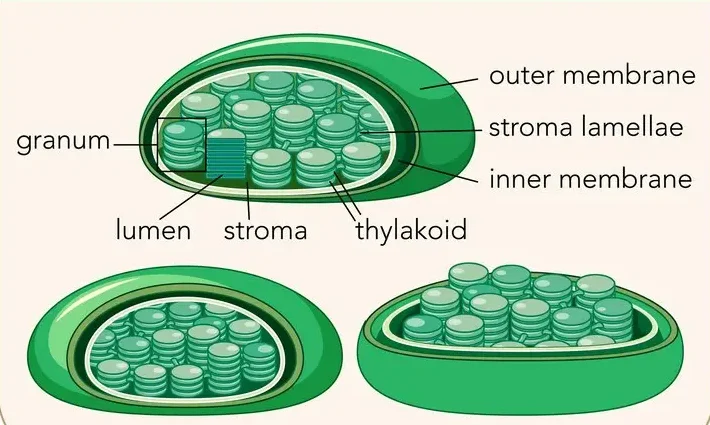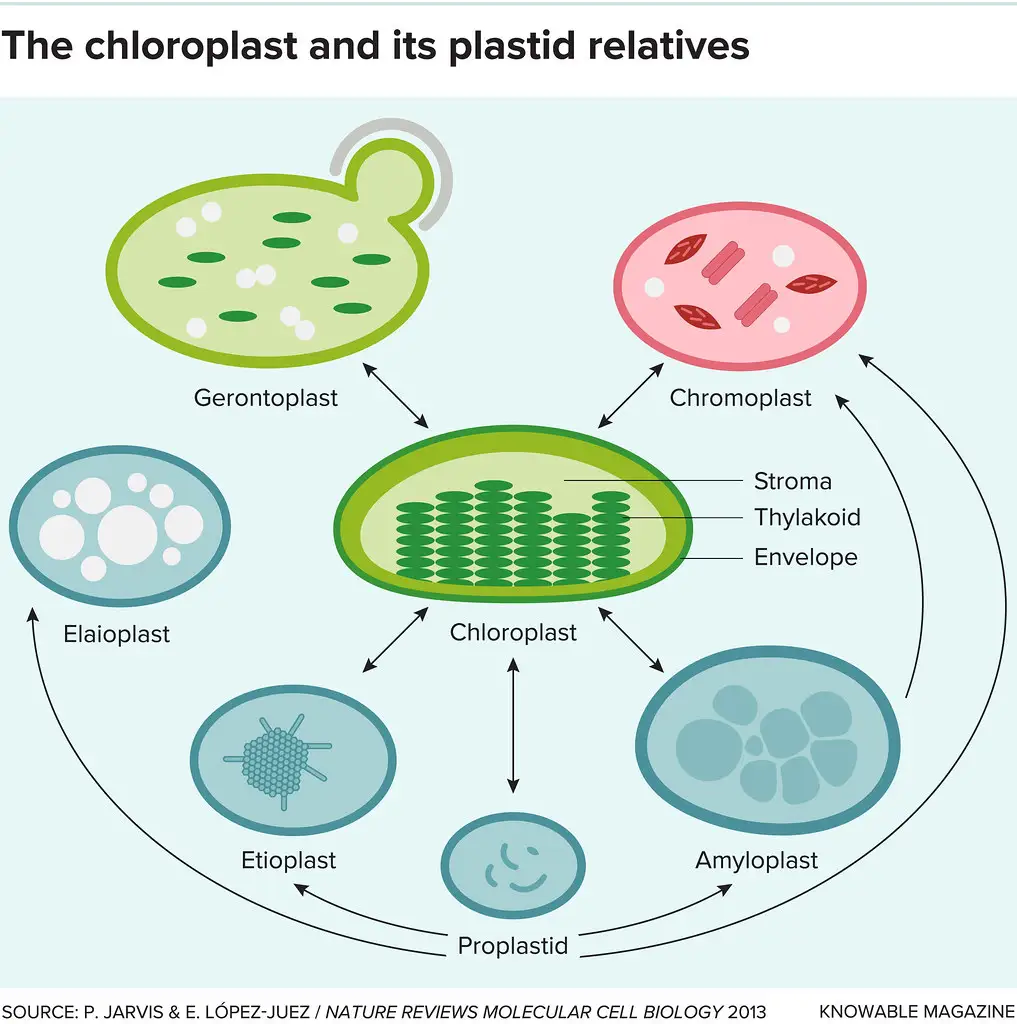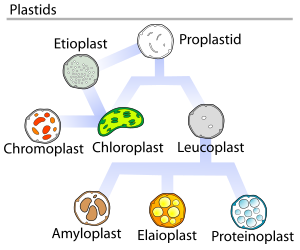Discovery:
Ernst Haeckel first introduced the term plastid, and Andrews Schimper provided a clear definition of plastids in 1833.
Plastids are double membrane-bound organelles inside plants and some algae, primarily responsible for making and storing food. Many plastids are photosynthetic, but some are not. Plastids are absent in animals.

Types of Plastids
- Chloroplast
- Chromoplasts
- Gerontoplasts
- Leucoplasts

1) Chloroplasts:
These green plastids are responsible for photosynthesis and energy production through glucose synthesis.
They contain a green pigment called chlorophyll that absorbs light energy. Chloroplasts are commonly found in specialized guard cells in plant leaves and stems. Guard cells open and close tiny pores called stomata to allow for gas exchange required for photosynthesis.
Also, Read chloroplasts
Structure of Chloroplast:
Chloroplast shows three main components envelope, stroma, and thylakoids. The envelope is a double membranous structure i.e. the inner and outer membrane.
Stroma covers most of the volume of the chloroplast. Stroma is a colorless fluid. It contains ribosomes, Proteins, and small circular DNA. Thylakoids are flattened vesicles that arrange themselves to form grana. A granum appears as a pile of thylakoids stacked on each other like coins.
The chloroplast appears green due to the presence of chlorophyll. Each granum is interconnected with the other by inter granum. It is also a self-replicating organelle.
2) Chromoplasts:
These colorful plastids are responsible for carotenoid pigment production and storage. Carotenoids produce red, yellow, and orange pigments. Chromoplasts are primarily located in ripened fruit, flowers, roots, and leaves of angiosperms.
i) Phacoplast:
Dark brown pigment. It contains fucoxanthin pigment and is found in brown algae and diatoms.
ii) Rhodoplast:
These are red colored. They contain phycoerythrin pigment. It is found in red algae.
3) Gerontoplasts
They are chloroplasts that come along with the natural aging process. Geronoplasts are a kind of chloroplast found in leaves.
They are formed after a leaf stops using photosynthesis, which typically occurs during the autumn months. Geronoplasts then allow the leaf to transform into a variety of other organelles.
4) Leucoplasts:
These are the non-pigmented organelles that are colorless. Leucoplasts are usually found in most of the non-photosynthetic parts of the plant, like roots.
They act as storage sheds for starches, lipids, and proteins depending on the needs of the plants. They are primarily used for converting amino acids and fatty acids.
Leucoplasts are of three types.
- Amyloplasts:
- Proteinoplasts:
- Elaioplasts:
Amyloplasts:
Amyloplasts are plastids that produce and store starch within internal membrane compartments. They are commonly found in vegetative plant tissues, such as tubers (potatoes) and bulbs.
Proteinoplasts:
Proteinoplasts help store the proteins a plant needs, typically found in seeds.
Elaioplasts:
Elaioplasts help in storing fats and oils that the plant needs.

FUNCTIONS OF PLASTIDS
- Chromoplasts provide yellow or red color to fruits, flowers, and vegetables.
- They help in the storage of proteins, starch, and oil.
- They trap solar energy to manufacture food through the process of photosynthesis.
- They help to maintain a balance between carbon dioxide and oxygen during photosynthesis.
- Chloroplast involved in the photosynthesis process
- Elaioplasts help in storing fats and oils that the plant needs.
- Proteinoplasts help store the proteins a plant needs, typically found in seeds.
- Amyloplasts are plastids that produce and store starch within internal membrane compartments.
- Leucoplast act as storage sheds for starches, lipids, and proteins depending on the needs of the plants. They are primarily used for converting amino acids and fatty acids.
Key Points
- Plastids are double membrane-bound organelles found inside plants and some algae and are primarily responsible for activities related to making and storing food.
- Chloroplasts are green plastids that absorb light energy and produce energy through glucose synthesis.
- A chloroplast is a double membranous structure that contains ribosomes, proteins, and small circular DNA. Thylakoids are flattened vesicles that arrange to form grana, interconnected by inter-granum.
- Chromoplasts provide color to fruits, flowers, and vegetables. They help store proteins, starch, and oil and trap solar energy to manufacture food through photosynthesis.
- Leucoplasts are non-pigmented organelles found in non-photosynthetic parts of plants. They are used for converting amino acids and fatty acids.
- Etioplasts are chloroplasts that have not been exposed to light. They can cause leaves to appear yellow rather than green.
FAQs about Plastids
Q. Which plastid helps store food in plants?
Ans: Leucoplasts act as storage sheds for starches, lipids, and proteins, depending on the needs of the plants. They are primarily used for converting amino acids and fatty acids.
Q. which plastids are colorless?
Ans: Leucoplasts are colorless plastids.
Q. which plastids bring about the process of photosynthesis?
Ans: Chloroplasts are green plastids that absorb light energy and bring about the process of photosynthesis.
Q. who discovered plastids?
Ans: The term plastid was first introduced by Ernst Haeckel, and Andrews Schimper provided a clear definition of plastid in 1833.
Q. Why are plastids important for plants?
Ans: Plastids are essential for plants because they are involved in the process of photosynthesis, food storage, and giving different colors to different parts of the plant
Q. Why plastids are called semi-autonomous organelles?
Ans: The term “semi-autonomous organelles” refers to the organelles in a cell that have their own copy of DNA and can multiply without the help of the nucleus.
Q. Which plastids store proteins?
Ans: Proteinoplasts help store the proteins that a plant needs and can be typically found in seeds.
Q. Which plastids help in photosynthesis?
Ans: Chloroplasts are green plastids that help in the process of photosynthesis.
Q. Where are plastids present in plants?
Ans: Plastids are present within the cytoplasm of the plant cell.
Q. How have plastids evolved?
Ans: Their origin is explained by endosymbiosis, the act of a unicellular heterotrophic protist engulfing a free-living photosynthetic cyanobacterium and retaining it, instead of digesting it in the food vacuole (Margulis 1970; McFadden 2001; Kutschera & Niklas 2005).
References
- https://www.researchgate.net/publication/233720054_The_Origin_of_Plastids
- https://www.nature.com/articles/nrm3702
- Book, Cell and Molecular Biology of Plastids edited by Ralph Bock
- https://byjus.com/biology/plastids/
- Book, The Structure and Function of Plastids edited by Robert R. Wise, J. Kenneth Hoober

Interesting. This looks super cool. I’ll be back to read more!